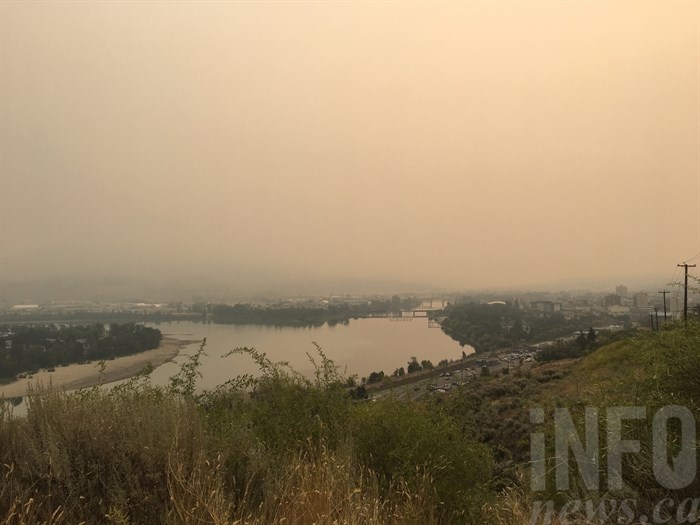
The worst recordings for air pollution were in Kamloops in early August 2017. This photo was taken in Lower Sahali looking east on Aug. 3, 2017.
(ASHLEY LEGASSIC / iNFOnews.ca)
August 18, 2021 - 7:30 AM
The Thompson and Okanagan have been buried in wildfire smoke this summer.
At least it seems that way.
But historical records show it was much worse during 2017 and 2018 when more than a million hectares of forest burned each year. So far, more than 811,000 hectares have burned in B.C. this year.
Peter Jackson, a professor of environmental sciences at the University of Northern B.C. did some digging into past records for the region at the request of iNFOnews.ca. He found the highest reading for particulate matter of 2.5 microns or smaller (the worst pollutant in wildfire smoke) in Kamloops and Okanagan regions in recent years was in Kamloops in 2017.
READ MORE: Here’s what those air quality warning numbers actually mean
The Kamloops Federal Building monitoring site showed that the highest 1 hour average PM2.5 level recorded was 861.7 micrograms per cubic metre on Aug. 3, 2017.
Kelowna never even go close to that. Its worst day was 458.9 micrograms per cubic meter on Aug. 19, 2018.
Vernon fared even better, maxing out at a mere 363.3, also on Aug. 19, 2018.
The data comes from government air quality monitors in each city. There is no similar station in Penticton.
By contrast, this summer has been relatively clear for Kamloops and Kelowna.
So far this year, the highest PM2.5 reading in Kamloops was 335.0 on Aug. 2.
Kelowna hit 295.9 on July 30 this year, far behind the 458.9 recorded in 2018.
READ MORE: Okanagan’s air quality takes a nose-dive; Kamloops improves slightly
Vernon, on the other hand, has fared slightly worse this year, hitting 364.5 on Aug. 15. Still, that’s only 1.2 micrograms per cubic metre more than in 2018.
The data comes from a B.C. government website that doesn’t show stations with PM2.5 readings from 2003, one of the most catastrophic fire seasons on record.
That was the year the Okanagan Mountain Park wildfire devastated the Kelowna area where more than 33,000 people were evacuated and 238 homes were destroyed. The McLure fire, north of Kamloops, destroyed 72 homes and nine businesses that year, mostly in the Louis Creek area south of Barriere, and 3,800 people were evacuated.
Despite the extensive property damage in 2003, only about 265,000 hectares burned in all of B.C.
READ MORE: B.C. is now well into its third worst wildfire season in the last 18 years
The readings cited above are averages recorded over one-hour periods but the data also comes with some caveats.
“Many of the B.C. Environment monitoring stations have changed/moved etc. and, also, the monitor technology changed over time, giving different readings,” Jackson wrote in an email.
The Kelowna monitoring station used to be at Okanagan College but was relocated to a location on KLO Road in 2019. The new technology gives higher readings, Jackson wrote.
The Kamloops monitoring station did not change but the monitors were upgraded in 2010.
The government air monitoring stations cost about $30,000 for each device and they test for many other pollutants than just the PM2.5 from wildfires. The cost of buying, monitoring and maintaining such equipment limits how many stations are established.
There are numerous Purpleair.com monitors in Kamloops and the North and Central Okanagan but none in the South Okanagan.
Those are $300 monitors that record PM2.5 only and upload the data on the Purpleair.com website.
Jackson, at the University of Northern B.C. has developed Cyclone.unbc.ca to “correct” the Purpleair.com data so it’s more in line with the more sophisticated government monitors. Even so, those monitors often show higher readings than the government stations cited here.
To contact a reporter for this story, email Rob Munro or call 250-808-0143 or email the editor. You can also submit photos, videos or news tips to the newsroom and be entered to win a monthly prize draw.
We welcome your comments and opinions on our stories but play nice. We won't censor or delete comments unless they contain off-topic statements or links, unnecessary vulgarity, false facts, spam or obviously fake profiles. If you have any concerns about what you see in comments, email the editor in the link above.
News from © iNFOnews, 2021